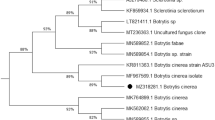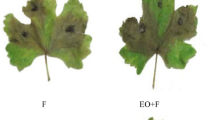Abstract
Commercial essential oils (EO) obtained from different parts of black cumin (N. sativa), mustard (S. nigra), St. John’s wort (H. perforatum), garlic (A. sativum), grape (V. vinifera), and ginger (Z. officinale) plants were evaluated for in vivo anti-mildew activity against pathotypes ‘771’ and ‘773’ of P.halstedii. The EOs were examined at concentrations of 0.2%, 0.4%, and 0.6% in susceptible sunflower variety ‘08-TR-003’ as seed, foliar, and seed + foliar treatments.It was concluded that seed treatments could be applicable and appropriate, due to the phytotoxic effects of foliar treatments at increasing concentrations. Moreover, it was observed that seed treatments with St. John’s wort, mustard, grape, ginger, or garlic EOs at a concentration of 0.6% exhibited anti-mildew activity with a decrease in sporangium quantity above 80% for pathotypes ‘771’ and ‘773’. Seed treatment with grape EO had the highest anti-mildew activity at a concentration of 0.6% and was found to be the most effective with a decrease in sporangium quantity above 90% for both pathotypes of the pathogen.
Similar content being viewed by others
References
Aala, F., Yusuf, U. K., Nulit, R., & Rezaie, S. (2014). Inhibitory effect of allicin and garlic extracts on growth of cultured hyphae. J. Basic Med. Sci., 17, 150–154.
Ayub, A., Dey, T. K., Rahan, M. Z., & Khatun, A. (1997). Effectiveness of some plant extracts in controlling powdery mildew of mungbean. Thai J. agric. Sci., 30, 471–476.
Ben-Jabeur, M., Ghabri, E., Myriam, M., & Hamada, W. (2015). Thyme essential oil as a defense inducer of tomato against gray mold and fusarium wilt. Plant Physiology and Biochemistry, 94, 35–40.
Bhatt, R., Awasthi, R. P., & Tewari, A. K. (2009). Management of downy mildew and white rust diseases of mustard. Pantnagar J. Research., 7(1), 54–58.
Borgen A and Lars K (2001) Effect of seed treatment with milk powder and mustard flour in control of common bunt (Tilletia tritici) in wheat and stem smut (Urocystis occulta) in rye. In: Biddle, a.J. (Ed.) proc. BCPC Symp. No. 76: Seed treatment: Challenges & opportunities. British crop protection council, Farnham.
Couladis, M., Chinou, I. B., Tzakou, O., & Petrakis, P. V. (2003). Composition and antimicrobial activity of the essential oil of Hypericum rumeliacum subsp. apollinis (Boiss. & Heldr.). Phytother res, 17(2), 152–154.
Cunningham, J. E., & Pickard, M. A. (1985). Maltol, a metabolite of Scytalidium uredinicola which inhibits spore germination of Endocronartium harknessii, the western gall rust. Canadian Journal of Microbiology, 31(11), 1051–1055.
Deans, S. G., & Svoboda, K. P. (1990). The antimicrobial properties of marjoram (Origanum majorana L.) volatile oil. Flavour Fragr. J., 187–190.
Deepak, S. A., Oros, G., Sathyanarayana, S. G., Shetty, N. P., Shetty, H. S., & Sashikanth, S. (2005). Antisporulant activity of leaf extracts of Indian plants against Sclerospora graminicola causing downy mildew disease of pearl millet. Archives of Phytopathology and Plant Protection, 38(1), 31–39.
Del Olmo, A., Calzada, J., & Nunez, M. (2017). Benzoic acid and its derivatives as naturally occurring compounds in foods and as additives: Uses, exposure, and controversy. Critical Reviews in Food Science and Nutrition, 57(14), 3084–3103.
Er Y (2018) Determination of the antifungal effects of some essential oils against downy mildew (Plasmopara halstedii) of sunflower. Ankara University graduate School of Natural and Applied Sciences. Department of Plant Protection. Ph. D. Thesis.117 p.
Er, Y., Ozer, N., & Katırcıoglu, Y. Z. (2020). Determination of anti-mildew activity of essential oils against downy mildew of sunflower caused by Plasmopara halstedii. J Plant Dis Prot., 127, 709–713. https://doi.org/10.1007/s41348-020-00310-4
Evci, G., Akın, K., Kaya, Y., Pekcan, V., & Yılmaz, M. (2011). The determination of downy mildew (Plasmopara halstedii (Farl.) Berl. & De Toni.) resistance of some sunflower lines in Trakya region. Anadolu, J. of. AARI, 21(1), 36–43.
Fernandez-Ocana, A. M., Gomez-Rodriguez, M. V., Velasco-Negueruela, A., Camacho-Simarro, A. M., Fernandez-Lopez, C., & Altarejos, J. (2004). In vivo antifungal activity of the essential oil ofBupleurum gibraltarium against Plasmopara halstedii in sunflower. J. Agric Food Chem, 52(21), 6414–6417.
Gudzic, B., Nedeljkovic, J., Dordevic, S., & Comor, J. (1997). Composition and antimicrobial activity of essential oil of Hyperici herb (Hypericum perforatum L.) from Vlasina region. Facta Universitatis, 1(4), 47–51.
Gulya, T. J., Miler, J. F., Firanyi, F., & Sackston, W. E. (1991). Proposed internationally standardized method for race identification of P. halstedii. Helia, 14, 11–20.
Gulya TJ, Tourvielle de la Brouhe D, Masirevic S, Penaud A, Rashid K., Viranyi F (1998) Proposal for standardized nomenclature and identification of races of Plasmopara halstedii (sunflower downy mildew). ISA Symposium III: Sunflower downy mildew, Fargo (ND, USA),p.130–136.
Gulya T, Draper M, Harbour J, Holen C, Knodel J, Lamey A, Mason P (1999) Metalaxyl resistance in sunflower downy mildew in North America. Proc. 21st sunflower research workshop, p. 118-123.
Gulya TJ (2001) Field and greenhouse evaluations of new fungicides for the control of metalaxyl-resistant sunflower downy mildew. Proc. 23rd sunflower research workshop, pp. 29-34.
Gulya TJ (2002) Efficacy of single and two-way fungicide seed treatments for the control of metalaxyl-resistant strains of Plasmopara halstedii (sunflower downy mildew). In: The BCPC conference - Pests & Diseases 2002. British crop protection council., pp. 575-580.
Gulya TJ (2007) Distribution of Plasmopara halstedii races from sunfower around the world. In: Proceedings of the 2nd international downy mildew symposium, 3, pp 121–134.
Kim, J. H., Lee, H. J., Jeong, S., Lee, M. H., & Kim, S. H. (2012). Essential oil of Pinus koraiensis leaves exerts antihyperlipidemic effects via up-regulation of low-density lipoprotein receptor and inhibition of acyl-coenzyme a: Cholesterol acyltransferase. Phytotherapy Research, 26, 1314–1319.
Kleingartner L (2005) The 2006 sunflower hybrids. Sunflower magazine. November. Htpp://www.sunflowernsa.com/magazine/details.asp?ID=397.
Kordali, S., Çakır, A., & Sutay, S. (2007). Inhibitory effects of monoterpenes on seed germination and seedling growth. Zeitschrift für Naturforschung, 62, 207–214.
La Torre, A., Mandala, C., Pezza, L., Caradonia, F., & Battaglia, V. (2014). Evaluation of essential plant oils for the control of Plasmopara viticola. Journal of Essential Oil Research, 26, 282–291.
Ljubich, A., & Gulya, T. J. (1988). Cotyledon-limited systemic downy mildew infection. Proceedings of 1988 sunflower research workshop (p. 9). National Sunflower Association.
Maskovic, P. Z., Mladenovic, J. D., Cvijovic, M. S., Dokovic, G. A., Solujic, S. R., & Radojkovic, M. M. (2011). Phenolic content, antioxidant and antifungal activities of acetonic, ethanolic and petroleum ether extracts of Hypericum perforatum L. Hemijska industrija, 65, 159–164.
Mounira, S., Ibtissem, S., Mouna, K., Boujemaa, K., & Boughalleb, N. (2011). Downy mildew of sunflowers in Tunisia and evaluation of four fungicides. Res.Plant Biol., 1(5), 27–32.
Naganawa, R., Iwata, N., Ishikawa, K., Fukuda, H., Fujino, T., & Suzuki, A. (1996). Inhibition of microbial growth by ajoene, a Sulphur containing compound derived from garlic. Applied and Environmental Microbiology, 62, 4238–4242.
Northover J, Schneider KE, Stobbs LW (1993) Control of grapevine diseases with oils, Proceedings 6th International Congress of Plant Pathology,Montreal,QC,71.
Park, M. J., Gwak, K. S., Yang, I., Kim, K. W., Jeung, E. B., Chang, J. W., & Choi, I. G. (2009). Effect of citral, eugenol, nerolidol and alpha-terpineol on the ultrastructural changes of Trichophyton mentagrophytes. Fitoterapia, 80, 290–296.
Parveen, M., Hasan, M. K., Takahashi, J., Murata, Y., Kitagawa, E., Kodama, O., & Iwahashi, H. (2004). Response of Saccharomyces cerevisiae to a monoterpene: Evaluation of antifungal potential by DNA microarray analysis. The Journal of Antimicrobial Chemotherapy, 54(1), 46–55.
Pinto, E., Pina-Vaz, C., Salgueiro, L., Goncalves, M. J., Costa-de-Oliveira, S., Cavaleiro, C., Palmeira, A., Rodrigues, A., & Martinez-de-Oliveira, J. (2006). Antifungal activity of the essential oil of Thymus pulegioides on Candida, aspergillus and dermatophyte species. Journal of Medical Microbiology, 55, 1367–1373.
Ragsdale, N. N., Henry, M. J., & Sisler, H. D. (1993). Minimizing nontarget effects of fungicides. Pest control with enhanced environmental safety. ACS Symposium Series, 524, 332–341.
Sakr, N., Ducher, M., Tourvieille, J., Walser, P., Vear, F., & De Labrouhe, D. T. (2007). Variation in form and size of Plasmopara halstedii (sunflower downy mildew) zoosporangia. Mycol.Prog., 7(4), 257–265.
Sakr, N. (2010). A plant mixture model against Plasmopara halstedii (sunflower DownyMildew). J. Plant Prot. Res., 50(2), 125–129.
Satapute, P., Kamble, M. V., Adhikari, S. S., & Jogaiah, S. (2019). Influence of triazole pesticides on tillage soil microbial populations and metabolic changes. Sci Total Environ, 651, 2334–2344.
Schiltz, P. (1974). Action inhibitrice de la β-ionone au cours du développement de Peronospora tabacina. Ann. Tabac., 11, 207–216.
Singh UP, Srivastava BP, Singh K.P, Mishra GD (1991) Control of pea powdery mildew with ginger extract. Indian Phytopathol 44:55–59.
Spring, O., Rozynek, B., & Zipper, Z. (1997). Leaf disk inoculation-a useful tool for selecting infections of sunflower downy mildew at low inoculum concentration, but inappropriate to pathotype characterization. Journal of Phytopathology, 145(4), 189–191.
Spring, O., Rozynek, B., & Zipper, R. (1998). Single spore infections with sunflower downy mildew. Journal of Phytopathology, 146(11/12), 577–579.
Spring, O. (2001). Nonsystemic infections of sunflower with Plasmopara halstedii and their putative role in the distribution of the pathogen. Journal of Plant Diseases and Protection, 108, 329–336.
Sudisha, J., Shigeru, M., Amruthesh, K. N., & Shetty, H. S. (2007). Activity of cyazofamid against Sclerospora graminicola, a downy mildew disease of pearl millet. Pest Management Science, 63(7), 722–727.
Sudisha, J., Niranjan-Raj, & Shekar Shetty, H. (2009). Seed priming with plant gum biopolymers enhances efficacy of metalaxyl 35 SD against pearl millet downy. Phytoparasitica, 37(2), 161–169.
Sudisha, J., Niranjana, S. R., Sukanya, S. L., Girijamba, R., Lakshmi Devi, N., & Shekhar Shetty, H. (2010). Relative efficacy of strobilurin formulations in the control of downy mildew of sunflower. Journal of Pest Science, 83, 461–470.
Tiwari, M., & Kakkar, P. (2009). Plant derived antioxidants-geraniol and camphene protect RatAlveolar macrophages against t-BHP induced oxidative stress. Toxicology In Vitro, 23, 295–301.
Vechet, L., Martinkova, J., Sindelarova, M., & Burketova, L. (2005). Compounds of natural origin inducing winter wheat resistance to powdery mildew (Blumeria graminis f. sp. tritici). Plant, Soil and Environment, 51, 469–475.
Vechet, L., Burketova, L., & Sindelarova, M. (2009). A comparative study of the efficiency of several sources of induced resistance to powdery mildew (Blumeria graminis f.sp. tritici) in wheat under field conditions. Crop protect, 28, 151–154.
Viranyi, F. (1977). An improved method for detecting systemic infection of sunflower seedlings caused by Plasmopara halstedii. Acta Phytopathologica Acad. Scientiarum Hungaricae, 12, 263–267.
Viranyi, F., & Spring, O. (2011). Advances in sunflower downy mildew research. Eur.J. Plant Pathol., 129, 207–220.
Wojdylo, A. (2015). Effect of vegetable and mineral oils on the development of Sphaerotheca pannosa var. rosae - the causal agent of powdery mildew of rose. Bulg. J. Agric. Sci., 21, 855–862.
Acknowledgments
The authors thank Central Research Laboratory (NABILTEM-NKU) for using GC/MS. The authors are grateful to Martha Rowe (University of Nebraska Lincoln) for improving the language and for her useful remarks.
Author information
Authors and Affiliations
Corresponding author
Ethics declarations
Human and/or animals rights
We confirm there was no research on any humans or animals.
Informed consent
All authors have reviewed the manuscript and consented to submission of the study to the European Journal of Plant Pathology.
Conflict of interest
The authors declare that they have no conflict of interest.
Rights and permissions
About this article
Cite this article
Er, Y., Özer, N. & Katırcıoğlu, Y.Z. In vivo anti-mildew activity of essential oils against downy mildew of sunflower caused by PLASMOPARA HALSTEDII. Eur J Plant Pathol 161, 619–627 (2021). https://doi.org/10.1007/s10658-021-02347-z
Accepted:
Published:
Issue Date:
DOI: https://doi.org/10.1007/s10658-021-02347-z




